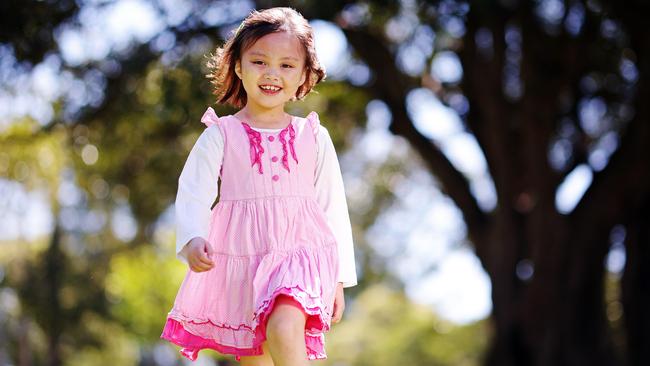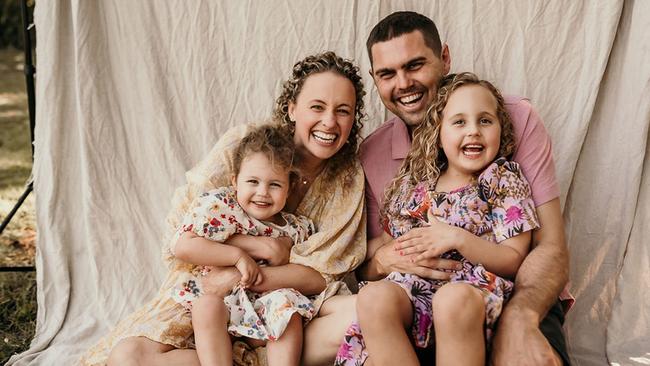Little Maddy’s bravery must be backed up by funding
Every year, 20 Australian children are given a death sentence, and within nine to 12 months most have left this Earth. The low-level of funding allocated to the disease that takes their lives is an anomaly the government must address, writes Mick Carroll.
Opinion
Don't miss out on the headlines from Opinion. Followed categories will be added to My News.
Sydney schoolgirl Maddy Suy is quite an incredible little girl. Her bravery and optimism takes your breath away. She is an inspiration to her parents and everyone who meets her – especially anyone who has witnessed firsthand her battle with a “monster in her head”.
She is fighting a malignant high grade brain stem glioma tumour known as a DIPG.
The average survival time is nine to 12 months. Maddy is nine.
She is one of the longest-known survivors of a DIPG in the world. Dr Charlie Teo bought her extra time three years ago with incredible surgery to shrink the mass, but the tumour is growing and Maddy is running out of time.
She is one of 20 children in Australia diagnosed with these aggressive tumours every year. To put it bluntly, the tumour is a death sentence – and desperate parents of these children are in the fight of their lives for government funding for research and medical trials.

Funding for such cancers is either abysmal or non-existent. The red tape that ties up parents, patients, researchers and doctors is impenetrable. And the cost of accessing far more progressive and forwardlooking research programs and treatment trials overseas is prohibitive.
According to the parent lobby groups, up until November this year the Australian government had allocated $970,000 to DIPG research, or approximately $5000 per diagnosed child since 2015.
In contrast, since 2018, more than $125m has been funded for childhood leukaemia research, roughly $92,500 per diagnosed child. This is 18 times more funding per child than DIPG.
The parents, of course, do not begrudge the level of funding for other childhood cancers. But they are incredulous about the lack of attention paid to a cancer that is so aggressive and affects such young children with their whole lives ahead of them.
Last month the federal government made the first real investment in years, announcing more than $700,000 for Dr Fatima Valdes Mora and a team from the University of NSW. But it is, of course, not enough. The parents and researchers have a clear goal – to double the lifespan of patients in the next five years.

They estimate they need at least $21m over the next three years to help their cause.
It seems like a reasonable number. Truth be told, they are probably aiming low, hoping a realistic request has a chance of being accepted.
The problem for all medical research is that it is a competitive business. The arm wrestle for both government funding and donor attention is cutthroat, with the highest-profile cancers receiving the lion’s share of available funds.
In the US, there are numerous properly managed trials available to patients.Those trials should be more readily available to Australian patients, to lessen the cost burden but also widen the pool of patients to increase the chances of finding a cure.
In Australia, the issue is further complicated by the controversy surrounding Dr Teo, who is one of the few surgeons prepared to attempt complicated surgeries on these patients, such as Maddy.
Those surgeries do not result in removal of the tumour but, as in the case of Maddy, they can buy some time as the search for medical solutions continues. The recent surgical restrictions placed on Dr Teo only serve to limit the options for these children and their families even more.

The question governments have to answer is why the lack of funding? Obviously they take into consideration the number of patients and the likelihood of success, which is understandable. But surely the low level of funding allocated is an anomaly they have to address.
Mum Hannah Pringle, who lost her six-year-old daughter Ruby early this year, summed the situation up perfectly.
“Without funding there’s no research. Without research there are no trials. Without trials there is no data and treatment options. Without trials there’s no options to fight or survival,” she said.
It is against this backdrop that the optimism and joy for life shown by Maddy seems all the more remarkable – and hopefully too much to ignore.
She is spending her lead-up to Christmas making a film and running a toy drive to bring some hope to other sick kids.
Let’s hope the government can follow suit and deliver a more substantial Christmas gift.




